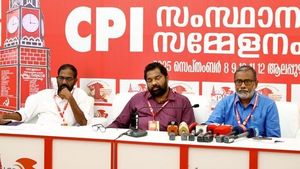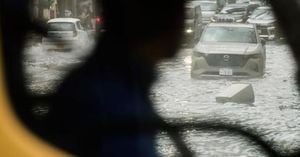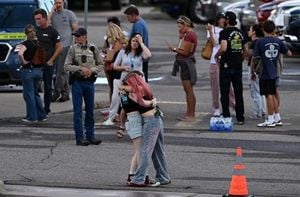On October 10, Tesla will finally reveal what many stakeholders hope will reshape the future of the automotive industry — its much-anticipated Robotaxi, humorously dubbed the "Cybercab" by CEO Elon Musk. This event, aptly named "We, Robot," is set against the backdrop of soaring expectations but also increasing skepticism about whether Tesla can truly deliver on its bold promises. For Musk, this is not just another launch; it's the moment to prove to investors and the world at large just how much Tesla has evolved beyond being just another car manufacturer.
Since its inception, Tesla has held itself up as the beacon of innovation, especially under Musk's leadership, often likened to the "Apple of the auto industry." The electric vehicle (EV) market's growth has been breathtaking, catalyzed by increasing consumer demand, environmental concerns, and technological advancements. But now, as big names like Ford, General Motors, and European brands like Volkswagen and BMW continue to roll out their own EV models, questions arise about whether Tesla's innovative edge is dulling. The stock, which reached extraordinary heights, is now hovering around 40% below its peak. That’s where the significance of Robotaxi Day looms large.
Expectations skyrocketed when Musk suggested we were on the cusp of unprecedented self-driving technology. His lofty predictions have created both anticipation and pressure; for years, he has insisted true autonomy was just around the corner. Yet, critics and even some investors are beginning to question whether the tech company is biting off more than it can chew. Musk has been known for setting ambitious timelines, many of which have proved to be overly optimistic, like the announcement of fully autonomous vehicles set to revolutionize not just Tesla, but the entire transportation infrastructure.
So, what's really at stake here? Well, the success or failure of the Robotaxi could provide clarity about Tesla's future. Analysts, including Emmanuel Rosner from Wolfe Research, observe, "The opportunity is massive, but they still have much to prove." After eight years of much-hyped deadlines and self-driving promises, the Robotaxi's success could either restore Tesla's luster among the tech elite or push it back to competing against other automakers for EV market share.
At the Robotaxi reveal, slated to occur at Warner Bros. Discovery’s movie studio, glimpses of the futuristic two-seater Cybercab are expected, alongside details on how this new venture will operate and be financially sustainable. The hopes are high, but as with any Musk venture, skepticism also runs rampant. Tesla has struggled with conceptual designs and practical execution time frames. The original launching plan was to showcase the Robotaxi back on August 8, just after Tesla scrapped plans to release more affordable EV models. Musk cited the need for pivotal design changes as the reason for the delay, exemplifying one of his favorite adages: move fast and break things.
Several questions loom large, such as how this new vehicle will integrate with ride-hailing services and function within existing legal frameworks. Significant logistics are involved beyond just building the cars; turns out, Tesla would also have to tread through regulatory waters and navigate state and local laws surrounding autonomous vehicles, which are still, as of now, touchy subjects. Indeed, critics have argued repeatedly about Musk's hands-off approach toward safety regulations.
While Musk projects audacity and optimism about Tesla's approach to autonomy—leaning heavily on optical cameras and neural networks for guidance over the more sensor-heavy methods employed by competitors like Waymo and Cruise—analysts have raised red flags. Waymo operates its fleet with the backing of powerful data and has managed to achieve around 100,000 rides per week without incident. And herein lies one huge disconnect; Musk's self-driving promises seem aspirational against tangible achievements like those displayed by Waymo.
Indeed, Musk himself acknowledges the need to push back against skepticism, admitting, "I tend to be overly optimistic." With the Tesla share price still riding high on the anticipation of this shift toward self-driving technology, investors are waiting for substantive evidence over promises made. Reports have suggested Tesla's Full-Self Driving (FSD) tech showcases impressive feats, but the data paints divided pictures, too. FSD tracker stats reveal relatively sobering realities; approximately every 100 miles, drivers still need to intervene, implying automobiles are not quite ready to operate solely on their own.
Despite the apparent pitfalls, investors seem ready to take the plunge alongside Musk. Yet even then, there’s hesitation. Tensions are clearly brewing among investors; they worry his flashy promises might overshadow or distract from real issues Tesla faces, including declining sales and increasing competition. Local sales dipped almost 10% compared to the previous year, alluding to the pressing urgency for fresh ideas and market perspectives. Amid such fierce competition, Tesla must show it can deliver more than just noise; real results are urgently needed to validate the company’s long-range plans.
And what does actuality look like on the horizon? It’s feasible we’ll find ourselves gazing at more than just the Cybercab prototype at Robotaxi Day. Speculations suggest Musk might enlighten the public about the elusive low-cost model—termed Model 2—if the rumors hold true, this could drastically widen Tesla's market reach, potentially catalyzing new sales channels and opportunities. Analysts have been raving about the Model 2 as being central to Tesla's revival after it suffered through subpar sales.
Also tantalizing? Could Tesla strike partnership deals with ride-share companies like Uber? Following the paths laid out by competitors, seizing such opportunities could mitigate initial public hesitation and provide existing infrastructure for what is sure to be another complicated venture. Given the challenges presented by its launch, it’s slightly surprising we haven't yet seen Tesla branch out actively to collaborate with external brands. History suggests Tesla could amplify its clout through partnership efforts.
The expectations surrounding the Robotaxi reveal are nothing short of seismic. On one hand, Musk has banked heavily on the potential of the model to wow investors and enthusiasts alike, reiteratively branding Tesla as more than just another car company. On the other hand, naysayers wonder if this Robotaxi will result not just as innovative marketing fluff, but deliver tangible, functional improvements and successes for the otherwise beleaguered company.
With countless challenges, including financial, technological, and regulatory, the stakes couldn't be higher. Given this whirlwind of hype and expectation around Tesla’s initiatives, any misstep on October 10 could leap effectively rip through the company's reputation, critically impacting the perceived value of its shares. If expectations aren’t met, even the most fervent Tesla enthusiasts might find themselves asking, "What’s next?"



